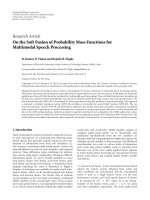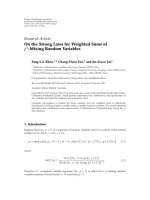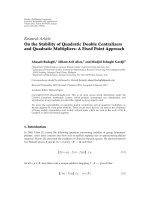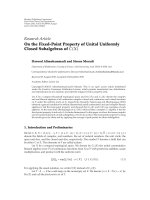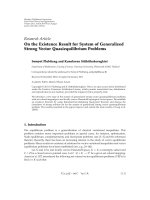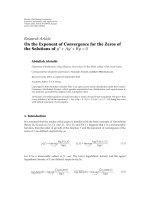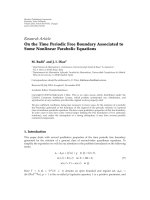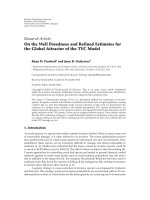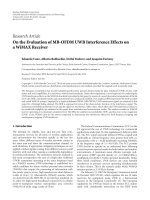Báo cáo hóa học: " Research Article On the Existence and Convergence of Approximate Solutions for Equilibrium Problems in Banach Spaces" pot
Bạn đang xem bản rút gọn của tài liệu. Xem và tải ngay bản đầy đủ của tài liệu tại đây (563.37 KB, 14 trang )
Hindawi Publishing Corporation
Journal of Inequalities and Applications
Volume 2007, Article ID 17294, 14 pages
doi:10.1155/2007/17294
Research Article
On the Existence and Convergence of Approximate Solutions for
Equilibrium Problems in Banach Spaces
Nan-Jing Huang, Heng-You Lan, and Kok Lay Teo
Received 15 June 2006; Revised 11 February 2007; Accepted 20 February 2007
Recommended by Charles Ejike Chidume
We introduce and study a new class of auxiliary problems for solving the equilibrium
problem in Banach spaces. Not only the existence of approximate solutions of the equi-
librium problem is proven, but also the strong convergence of approximate solutions to
an exact solution of the equilibrium problem is shown. Furthermore, we give some itera-
tive schemes for solving some generalized mixed variational-like inequalities to illuminate
our results.
Copyright © 2007 Nan-Jing Huang et al. This is an open access article distributed under
the Creative Commons Attribution License, which permits unrestricted use, distribution,
and reproduction in any medium, provided the original work is properly cited.
1. Introduction
Let X be a real Banach space with dual X
∗
,letK ⊂ X be a nonempty subset, and let f :
K
× K → R
=
(−∞,+∞) be a given bifunction. By the equilibrium problem int roduced
by Blum and Oettli in [1], we can formulate the following equilibrium problem of finding
an
x ∈ K such that
f (
x, y) ≥ 0, ∀y ∈ K, (1.1)
where f (x,x)
= 0forallx ∈ K.
The following is a list of special cases of problem (1.1).
(1) If f (x, y)
=N(x,x),η(y,x) +b(x, y) − b(x,x)forallx, y ∈ K,whereN : K × K →
X
∗
, η : K × K → X,andb : K × K → R, then the problem of finding an x ∈ K such that
N(x, x),η(y, x)
+ b(x, y) − b(x, x) ≥ 0, ∀y ∈ K, (1.2)
2 Journal of Inequalities and Applications
is a special case of problem (1.1). This problem is known as the generalized mixed
variational-like inequality. Problem (1.2) was considered by Huang and Deng [2]inthe
Hilbert space setting with set-valued mappings.
(2) If X
= X
∗
= H is a Hilbert space, N(x, y) = Tx − Ay,andb(x, y) = m(y)forall
x, y
∈ K,whereT, A,m : K → X
∗
,thenproblem(1.2) reduces to the following mixed
variational-like inequality problem, which is to find an
x ∈ K such that
T(x) − A(x), η(y, x)
+ m(y) − m(x) ≥ 0, ∀y ∈ K. (1.3)
This problem was introduced and studied by Ansari and Yao [3] and Ding [4].
Remark 1.1. Through appropriate choices of the mappings f , N, η,andb, it can be easily
shown that problem (1.1) covers many known problems as special cases. For example, see
[1–8] and the references therein.
It is well known that many interesting and complicated problems in nonlinear analy-
sis, such as nonlinear programming, optimization, Nash equilibria, saddle points, fixed
points, variational inequalities, and complementarity problems (see [1, 9–12] and the
references therein), can all be cast as equilibrium problems in the form of problem (1.1).
There are several papers available in the literature which a re devoted to the develop-
ment of iterative procedures for solving some of these equilibrium problems in finite as
well as infinite-dimensional spaces. For example, some proximal point algor ithms were
developed based on the Bregman functions, see [13–18]. For other related works, we refer
to [10, 12] and the references therein.
In [8], Iusem a nd Sosa presented some iterative algorithms for solving equilibrium
problems in finite-dimensional spaces. They have also established the convergence of the
algorithms In [19], Chen and Wu introduced an auxiliary problem for the equilibrium
problem (1.1). They then showed that the approximate solutions generated by t he auxil-
iary problem converge to the exact solution of the equilibrium problem (1.1)inHilbert
space.
In this paper, a new class of auxiliary problems for t he equilibrium problem (1.1)
in Banach space is introduced. We show the existence of approximate solutions of the
auxiliary problems for the equilibrium problem, and establish the strong convergence
of the approximate solutions to an exact solution of the equilibrium problem. Then, we
develop an iterative scheme for solving problems (1.2)and(1.3). Our results extend and
improve the corresponding results reported in [3, 4, 19].
2. Preliminaries
Throughout this paper, let X be a real Banach space and X
∗
its dual, let ·,· be the dual
pair between X and X
∗
,andletK be a nonempty convex subset of X.
In the sequel, we give some preliminary concepts and lemmas.
Nan-Jing Huang et al. 3
Definit ion 2.1 (see [20, 21]). Let η : K
× K → X.Adifferentiable function h : K → R on a
convex set K is said to be
(i) η-convex if
h(y)
− h(x) ≥
h
(x), η(y,x)
, ∀x, y ∈ K, (2.1)
where h
(x) denotes the Fr
´
echet derivative of h at x;
(ii) μ-η-strongly convex if t here exists a constant μ>0suchthat
h(y)
− h(x) −
h
(x), η(y,x)
≥
μ
2
x − y
2
, ∀x, y ∈ K. (2.2)
Remark 2.2. If η(x, y)
= x − y for all x, y ∈ K, then (i)-(ii) of Definition 2.1 reduce to the
definitions of convexity and st rong convexity, respectively.
Remark 2.3. h
is strongly monotone with the constant σ>0ifh is strongly convex with
aconstantσ/2. In fact, by the strong convexity of h,wehave
h
(x) − h
(y),x − y
=
h
(x), x − y
−
h
(y),x − y
=
h(y) − h(x) −
h
(x), y − x
+ h(x) − h(y) −
h
(y),x − y
≥
σ
2
x − y
2
+
σ
2
x − y
2
= σx − y
2
.
(2.3)
Definit ion 2.4. Let η : K
× K → X be a single-valued mapping. For all x, y ∈ E,themap-
ping N : K
× K → X
∗
is said to be
(i) ρ-η-coercive with respect to the first argument if there exists a ρ > 0suchthat
N(x,·) − N(y,·),η(x, y)
≥
ρ
N(x,·) − N(y,·)
2
, ∀x, y ∈ K; (2.4)
(ii) σ-η-strongly monotone with respect to the second argument if there exists a con-
stant σ > 0suchthat
N(·,x) − N(·, y),η(x, y)
≥
σx − y
2
, ∀x, y ∈ K; (2.5)
(iii) σ-Lipschitz continuous with respect to the second argument if there exists a con-
stant σ>0suchthat
N(·,x) − N(·, y)
≤
σ
x − y
, ∀x, y ∈ K. (2.6)
Definit ion 2.5. Let η : K
× K → X. The mapping T : K → X
∗
is said to be
(i) α-η-coercive if there exists an α>0suchthat
T(x) − T(y),η(x, y)
≥
α
T(x) − T(y)
2
, ∀x, y ∈ K; (2.7)
(ii) β-η-strongly monotone if there exists a β>0suchthat
T(x) − T(y),η(x, y)
≥
β
x − y
2
, ∀x, y ∈ K; (2.8)
4 Journal of Inequalities and Applications
(iii) η-monotone if
T(x) − T(y),η(x, y)
≥
0, ∀x, y ∈ K; (2.9)
(iv) δ-η-relaxed monotone if there exists a δ>0suchthat
T(x) − T(y),η(x, y)
≤−
δx − y
2
, ∀x, y ∈ K; (2.10)
(v)
-Lipschitz continuous if there exists an > 0suchthat
T(x) − T(y)
≤
x − y, ∀x, y ∈ K. (2.11)
Remark 2.6. If η(x, y)
= x − y for all x, y ∈ K, then (i)–(iv) of Definition 2.5 reduce to
the definitions of coerciveness, strong monotonicity, monotonicity, relaxed monotonic-
ity, respectively. Obviously, the η-coerciveness implies η-monotonicity.
Definit ion 2.7. The mapping η : K
× K → X is said to be τ-Lipschitz continuous if there
exists a τ>0suchthat
η(x, y)
≤
τx − y, ∀x, y ∈ K. (2.12)
Remark 2.8. It is easy to see that T is α-η-coercive if T is β-η-strongly m onotone and
α/β-Lipschitz continuous. On the other hand if T is α-η-coercive and η is τ-Lipschitz
continuous, then T is τ/α-Lipschitz continuous.
Definit ion 2.9 (see [22]). A mapping F : K
→ R is called sequentially continuous at x
0
if
for any sequence
{x
n
}⊂K such that x
n
− x
0
→0, then F(x
n
) → F(x
0
). F is said to be
sequentially continuous on K if it is sequentially continuous at each x
0
∈ K.
Definit ion 2.10. Let E be a nonempty subset of a real topological vector space X.Aset-
valued function Φ : E
→ 2
X
is said to be a KKM mapping if for any nonempty finite set
A
⊂ E,
co(A)
⊂
x∈A
Φ(x), (2.13)
where co(A) denotes the convex hull of A.
Lemma 2.11 (see [23]). Let K be a nonempty convex subset of a real Hausdorff topological
vector space X,andletΦ : K
→ 2
X
be a KKM mapping. Suppose that Φ(x) is closed in X for
every x
∈ K, and that there is a point x
0
∈ K such that Φ(x
0
) is compact. Then,
x∈K
Φ(x) =∅. (2.14)
Lemma 2.12. Let A : K
→ X
∗
be sequentially continuous from the weak topology to the
strong topology. Suppose that for a fixed y
∈ K, x → η(y,x) is a sequentially continuous
mapping from the w eak topology to the weak topology. Define f (x)
=A(x), η(y, x).Then,
f (x) is a sequentially continuous mapping from the weak topology to the strong topology.
Nan-Jing Huang et al. 5
Proof. If x
n
→ x
0
with the weak topology, then A(x
n
) → A(x
0
), and for any fixed y ∈ K,
η(y,x
n
) → η(y,x
0
) with the weak topology. Clearly,
f
x
n
−
f
x
0
=
A
x
n
,η
y,x
n
−
A
x
0
,η
y,x
0
=
A
x
n
−
A
x
0
,η
y,x
n
−
A
x
0
,η
y,x
n
−
η
y,x
0
≤
A
x
n
−
A
x
0
·
η
y,x
n
+
A
x
0
,η
y,x
n
−
η
y,x
0
.
(2.15)
By the boundedness property of the weak convergence sequence, we see that
η(y,x
n
) is
bounded. Thus, it follows that
| f (x
n
) − f (x
0
)|→0. This completes the proof.
Lemma 2.13 (see [24]). Let K be a nonempty c onvex subset of a topological vector space.
Suppose that φ : K
× K → (−∞,+∞] is a mapping such that the following conditions are
satisfied.
(1) For each y
∈ K, x → φ(y,x) is semicontinuous on every compact subset of K.
(2) If x
=
n
i
=1
λ
i
y
i
,where{y
1
, y
2
, , y
n
}is any nonempty finite set in K,whileλ
i
≥ 0,
i
= 1,2, ,n, such that
n
i
=1
λ
i
= 1, then min
1≤n≤n
φ(y
i
,x) ≤ 0.
(3) There exist a nonempty compact convex subset K
0
of K and a nonempty compact
subset D
0
of K such that for each x ∈ K\D
0
, there exists a y ∈ co(K
0
∪{x}) such
that φ(y,x) > 0.
Then, the re exists an x
0
∈ K such that φ(y,x
0
) ≤ 0 for all y ∈ K.
3. Main results
In this section, we first deal with the approximate solvability of problem (1.1). Let X be a
reflexive Banach space and X
∗
its dual, and let K be a nonempty convex subset of X.We
introduce an auxiliary function ϕ : K
→ R which is differentiable. Then, we construct the
auxiliary problem for problem (1.1)asfollows.
For any given x
n
∈ K,findanx
n+1
∈ K such that
ρf
x
n
, y
−
ρf
x
n
,x
n+1
+
ϕ
x
n+1
−
ϕ
x
n
, y − x
n+1
≥
0, ∀y ∈ K, (3.1)
where
·,· denotes the dual pair between X and X
∗
, ρ>0 is a constant, and ϕ
(x)isthe
Fr
´
echet derivative of ϕ at x.
We note that x
n
is a solution of problem (1.1)whenx
n+1
= x
n
.
Remark 3.1. If ρ
= 1, then the auxiliary problem for problem (3.1) reduces to the auxiliary
problem studied by Chen and Wu [19].
Similarly, we can construct the auxiliary problems (3.2)and(3.3) for problems (1.2)
and (1.3), respectively.
(1) If f (x, y)
=N(x,x),η(y, x) + b(x, y) − b(x,x)forallx, y ∈ K,whereN : K ×
K → X
∗
, η : K × K → X,andb : K × K → R,thenforanygivenx
n
,problem(3.1)
is equivalent to finding an x
n+1
such that
ϕ
x
n+1
, y − x
n+1
≥
ϕ
x
n
, y − x
n+1
−
ρ
N
x
n
,x
n
,η
y,x
n+1
+ ρb
x
n
,x
n+1
−
ρb
x
n
, y
, ∀y ∈ K.
(3.2)
6 Journal of Inequalities and Applications
(2) If X, T, A, m are the same as in problem (1.3), then for a given iterate x
n
,problem
(3.2) reduces to the following problem of finding an x
n+1
such that
ρ
T
x
n
−
A
x
n
+ ϕ
x
n+1
−
ϕ
x
n
,η
y,x
n+1
+ ρ
m(y) − m
x
n+1
≥
0, ∀y ∈ K.
(3.3)
Now, we are in a position to state and prove the main results of the paper.
Theorem 3.2. Let X be a reflexive Banach space with dual space X
∗
and let K be a nonempty
convex subset of X.Supposethat f : K
× K → R is a bifunction and ϕ : K → R is a differen-
tiable function. Furthermore, for all x, y,z
∈ K, assume that the following conditions are
satisfied.
(i) y
→ f (x, y) is affine and weakly lower semicontinuous.
(ii) ϕ
is μ-strongly monotone and sequentially continuous from the weak topology to the
strong topology.
(iii) ThereexistacompactsetC
⊂ K and a vector y
0
∈ K such that for any ρ>0,
ρf
x
n
,x
−
ρf
x
n
, y
0
>
ϕ
(x) − ϕ
x
n
, y
0
− x
, ∀x ∈ K\C. (3.4)
Then, auxiliary problem (3.1) admits a unique solution x
n+1
∈ K. In addition, suppose that
the following condition is also satisfied.
(iv) There exist constants a
≤ 0, b>0,andc ∈ R such that
f
x
n
,x
n+1
−
f
x
n
,z
−
f
z, x
n+1
≥
a
x
n
− x
n+1
2
+ b
x
n
− z
2
+ c
x
n
− x
n+1
·
x
n
− z
(3.5)
for all z ∈ K and n = 0, 1,2,
If the original problem (1.1)hasasolutionand
μ +2aρ
≥ 0, 0 <ρ<
2bμ
c
2
− 4ab
, (3.6)
then the sequence
{x
n
} generated by (3.1) converges to a solution of equilibrium prob-
lem (1.1).
Proof. Let
S(y)
=
x ∈ K | ρf
x
n
, y
−
ρf
x
n
,x
+
ϕ
(x) − ϕ
x
n
, y − x
≥
0
. (3.7)
If
y∈K
S(y) =∅, then there exists a solution to ( 3.1).
Since y
∈ S(y)forally ∈ K, S(y) =∅, it follows from (iii) that for any x ∈ K\C,
ρf
x
n
, y
0
−
ρf
x
n
,x
+
ϕ
(x) − ϕ
x
n
, y
0
− x
< 0. (3.8)
That is, x
∈ S(y
0
). Thus, S(y
0
) ⊂ K ∩ C.SinceC is compact, there exists a y
0
∈ K such
that
S(y
0
)isalsocompact.
For any finite subset
{t
1
,t
2
, ,t
r
}⊂K,letco{t
1
, ,t
r
} be its convex hull. If
t
∈ co({t
i
}
r
i
=1
), then t=
r
i
=1
λ
i
t
i
with λ
i
≥ 0, i= 1,2, ,r,and
r
i
=1
λ
i
= 1. If t ∈
r
i
=1
S(t
i
),
Nan-Jing Huang et al. 7
then t
∈ S(t
i
)foralli = 1,2, ,r.Hence,
ρf
x
n
,t
i
−
ρf
x
n
,t
+
ϕ
(t) − ϕ
x
n
,t
i
− t
< 0, (3.9)
and so
r
i=1
λ
i
ρf
x
n
,t
i
−
λ
i
ρf
x
n
,t
+ λ
i
ϕ
(t) − ϕ
x
n
,t
i
− t
< 0. (3.10)
Since t
=
r
i
=1
λ
i
t
i
, it follows from (i) that
f
x
n
,t
=
r
i=1
λ
i
f
x
n
,t
i
<f
x
n
,t
, (3.11)
which is a contradiction. Therefore,
co
t
1
,t
2
, ,t
r
⊂
r
i=1
S
t
i
⊂
r
i=1
S
t
i
. (3.12)
By Lemma 2.11,
y∈K
S(y) =∅.
Set
x ∈
y∈K
S(y). Then, x ∈ S(y)forally ∈ K and there exists a sequence {u
k
}⊂S(y)
such that u
k
→ x. It follows that
ρf
x
n
, y
−
ρf
x
n
,u
k
+
ϕ
u
k
−
ϕ
x
n
, y − u
k
≥
0. (3.13)
Since y
→ f (x, y) is weakly lower semicontinuous and ϕ
is sequentially continuous from
the weak topology to the strong topology, as k
→∞,wehave
ρf
x
n
, y
−
ρf
x
n
,x
+
ϕ
(x) − ϕ
x
n
, y − x
≥
0, (3.14)
which implies that
x ∈ S(y)forally ∈ K. Therefore,
y∈K
S(y) =∅.
Now, we will prove that the solution of (3.1) is unique. In fact, if there exist
x
1
,x
2
∈
y∈K
S(y) ⊂ K with x
1
= x
2
,then
ρf
x
n
, y
−
ρf
x
n
,x
1
+
ϕ
x
1
−
ϕ
x
n
, y − x
1
≥
0, ∀y ∈ K, (3.15)
ρf
x
n
, y
−
ρf
x
n
,x
2
+
ϕ
x
2
−
ϕ
x
n
, y − x
2
≥
0, ∀y ∈ K. (3.16)
Setting y
= x
2
in (3.15)andy = x
1
in (3.16), we get
ρf
x
n
,x
2
−
ρf
x
n
,x
1
+
ϕ
x
1
−
ϕ
x
n
,x
2
− x
1
≥
0, (3.17)
ρf
x
n
,x
1
−
ρf
x
n
,x
2
+
ϕ
x
2
−
ϕ
x
n
,x
1
− x
2
≥0. (3.18)
Adding (3.17)to(3.18), we obtain
ϕ
x
1
,x
2
− x
1
+
ϕ
x
2
,x
1
− x
2
≥
0. (3.19)
8 Journal of Inequalities and Applications
Since ϕ is strictly convex with constant μ>0, it holds that
ϕ
x
2
−
ϕ
x
1
−
μ
2
x
2
− x
1
2
+ ϕ
x
1
−
ϕ
x
2
−
μ
2
x
2
− x
1
2
≥ 0, (3.20)
that is,
−μ
x
2
− x
1
2
≥ 0. (3.21)
This contradicts with μ>0and
x
1
= x
2
. Hence, problem (3.1) admits a unique solution,
which is denoted by x
n+1
.
Let
x be a solution of the original problem (1.1). For each y ∈ K, we define a function
Θ : K
→ R by
Θ(y)
= ϕ(x) − ϕ(y) −
ϕ
(y), x − y
. (3.22)
It follows from the strict convexity of ϕ that
Θ(y)
≥
μ
2
x − y
2
≥ 0, (3.23)
Θ
x
n
−
Θ
x
n+1
=
ϕ(x)−ϕ
x
n
−
ϕ
x
n
, x−x
n
−
ϕ(x)+ϕ
x
n+1
+
ϕ
x
n+1
, x−x
n+1
=
ϕ
x
n+1
−
ϕ
x
n
−
ϕ
x
n
, x − x
n
+
ϕ
x
n+1
, x − x
n+1
=
ϕ
x
n+1
−
ϕ
x
n
−
ϕ
x
n
,x
n+1
−x
n
+
ϕ
x
n+1
−
ϕ
x
n
, x−x
n+1
≥
μ
2
x
n+1
− x
n
2
+
ϕ
x
n+1
−
ϕ
x
n
, x − x
n+1
.
(3.24)
Setting y
=
x in (3.1 ), we have
ρf
x
n
, x
−
ρf
x
n
,x
n+1
+
ϕ
x
n+1
−
ϕ
x
n
, x − x
n+1
≥
0, (3.25)
that is,
ϕ
x
n+1
−
ϕ
x
n
, x − x
n+1
≥
ρf
x
n
,x
n+1
−
ρf
x
n
, x
. (3.26)
Let y
= x
n+1
in (1.1). Then, f (x,x
n+1
) ≥ 0, and so
ρf
x, x
n+1
≥
0. (3.27)
By (3.24)–(3.27), we have
Θ
x
n
−
Θ
x
n+1
≥
μ
2
x
n+1
− x
n
2
+ ρf
x
n
,x
n+1
−
ρf
x
n
, x
−
ρf
x, x
n+1
=
μ
2
x
n+1
− x
n
2
+ ρQ,
(3.28)
where Q
= f (x
n
,x
n+1
) − f (x
n
, x) − f (x,x
n+1
). From assumption (iv), there exist constants
a
≤ 0, b>0andc ∈ R,suchthat
Q ≥ a
x
n
− x
n+1
2
+ b
x
n
− x
2
+ c
x
n
− x
·
x
n+1
− x
n
. (3.29)
Nan-Jing Huang et al. 9
Combining (3.28)and(3.29), we have
Θ
x
n
−
Θ
x
n+1
≥
μ
2
+ aρ
x
n+1
− x
n
2
+ bρ
x
n
− x
2
+ cρ
x
n
− x
·
x
n+1
− x
n
=
μ
2
+ aρ
x
n+1
− x
n
+
cρ
μ +2aρ
x
n
− x
2
+
bρ −
(cρ)
2
2(μ +2aρ)
x
n
− x
2
≥
bρ −
(cρ)
2
2(μ +2aρ)
x
n
− x
2
.
(3.30)
It follows from (3.6)and(3.30)that
Θ
x
n
−
Θ
x
n+1
≥
0. (3.31)
From (3.31), we know that
{Θ(x
n
)} is a decreasing sequence with infimum, so it con-
verges to some number. Hence, lim
n→∞
[Θ(x
n
) − Θ(x
n+1
)] = 0. It follows from (3.30)that
lim
n→∞
x
n
=
x. This completes the proof.
Remark 3.3. Suppose that x → f (x, y) is additive (i.e., f (x + y,u) = f (x,u)+ f (y, u)for
all x, y,u
∈ K), that y → f (x, y) is also additive, and that there exists a constant ν > 0such
that f (x, y)
≥ νx·y. Then, by the fact that f (z,z) = 0forallz ∈ K,wehave
f
x
n
,x
n+1
−
f
x
n
,z
−
f
z, x
n+1
=
f
x
n
− z,x
n+1
−
f
x
n
− z,z
=
f
x
n
− z,x
n+1
− z
=
f
x
n
− z,x
n+1
− x
n
+ f
x
n
− z,x
n
− z
≥
ν
x
n
− z
2
+ ν
x
n
− z
·
x
n+1
− x
n
=
0 ·
x
n+1
− x
n
2
+ ν
x
n
− z
2
+ ν
x
n
− z
·
x
n+1
− x
n
.
(3.32)
Let a
= 0, b = c = ν. Then, the assumption (iv) of Theorem 3.2 holds. Therefore, our
results extend, improve, and unify the corresponding results obtained by Chen and Wu
in [19].
Theorem 3.4. Let K and X be the same as in Theorem 3.2.LetN : K
× K → X
∗
and η :
K
× K → X be two mappings, and let b : K × K → R and ϕ : K → R be two functions. Suppose
that the following conditions are satistified.
(i) N(
·,·) is α-η-coercive with respect to the first argument and is ξ-η-strongly mono-
tone and β-Lipschitz continuous with respect to the second argument, y
→N(x,x),
η(y,x)
is concave, and N is sequentially continuous from the weak topology to the
strong topology with respect to the first argument and the second argument.
(ii) η(x, y)
= η(x,z)+η(z, y) for all x, y,z ∈ K, η is λ-Lipschitz continuous and for any
given y
∈ K, x → η(y,x) is sequent ially continuous from the weak topology to the
weak topology.
(iii) b(
·,·) is linear with respect to the first argument and convex lower semicontin-
uous with respect to the second argume nt, there exists a constant 0 <γ<β such
10 Journal of Inequalities and Applications
that b(x, y)
≤ γxy for all x, y ∈ K,andb(x, y) − b(x,z) ≤ b(x, y − z) for all
x, y,z
∈ K.
(iv) ϕ is μ-strongly convex and its Fr
´
echet der ivative ϕ
is sequentially continuous from
the weak topology to the strong topology.
Then, the re exists a unique solution x
n+1
∈ K for auxiliary problem (3.2). In addition, if the
original problem (1.2)hasasolutionand
μ
−
λ
2
ρ
2α
≥ 0, 0 <ρ<
2μα(ξ
− γ)
α(βλ + γ)
2
+(ξ − γ)λ
2
, ξ>γ>0, (3.33)
then the sequence
{x
n
} generated by (3.2) converges to a solution of generalized mixed vari-
ational-like inequality problem (1.2).
Proof. Since η(x, y)
= η(x,z)+η(z, y)forallx, y,z ∈ K,itiseasytoseethat
η(x,x)
= 0, η(x, y)+η(y,x) = 0, ∀x, y ∈ K. (3.34)
Let f (x, y)
=N(x,x),η(y,x) + b(x, y) − b(x, x)forallx, y ∈ K. Then, the following
results follow.
(a) Assumptions (ii) and (iii) imply that condition (i) of Theorem 3.2 holds.
(b) From (3.33), (3.34), and assumptions (i)–(iii), we have
f (x, y)
− f (x,z) − f (z, y)
=
N(z,z) − N(x,z),η(z,x)
+
N(x,z) − N(x,x),η(z,x)
−
N(z,z) − N(x,z),η(y,x)
−
N(x,z) − N(x,x),η(y,x)
−
b(x − z,z − x) − b(x − z,x − y)
≥ α
N(z,z) − N(x,z)
2
+ ξ
z − x
2
−
N(z,z) − N(x,z)
·
η(y,x)
−
N(x,z) − N(x,x)
·
η(y,x)
−
γ
x − z
2
− γx − z·x − y
≥
α
N(z,z) − N(x,z)
2
− λ
N(z,z) − N(x,z)
·
y − x + ξz − x
2
− βλz − x·y − x−γx − z
2
− γx − z·x − y
=
α
N(z,z) − N(x,z)
−
λ
2α
x − y
2
−
λ
2
4α
x − y
2
+(ξ − γ)z − x
2
− (βλ +γ)x − z·x − y
≥
ax − y
2
+ bx − z
2
+ cx − y·x − z
(3.35)
for all x, y,z
∈ K,where
a
=−
λ
2
4α
< 0, b
= ξ − γ>0, c =−(βλ + γ). (3.36)
This implies that assumption (iv) of Theorem 3.2 holds.
Nan-Jing Huang et al. 11
(c) By assumption (iv), it is easy to see that assumption (ii) of Theorem 3.2 holds.
(d) Assumption (iii) of Theorem 3.2 can be obtained by Lemmas 2.12 and 2.13,and
conditions (i) and (iii) (see [2]).
Thus, the conclusions of the theorem follows from the argument similar to that given
for Theorem 3.2. This completes the proof.
Theorem 3.5. Let K beanonemptyconvexsubsetofarealHilbertspaceH.Letm : K → R
be a lower semicontinuous and convex functional, let T, A : K → H be two mappings such
that T is α-η-coercive and A is ξ-η-relaxed monotone and β-Lipschitz continuous. Assume
that
(i) η : K
× K → H is λ-Lipschitz continuous such that
(a) η(x, y)
= η(x,z)+η(z, y) for all x, y,z ∈ K,
(b) η(
·,·) is affine in the first variable,
(c) for each fixed y
∈ K, x → η(y,x) is sequentially continuous from the weak
topology to the weak topology;
(ii) ϕ : K
→ R is μ-η-strongly convex and its de rivative ϕ
is sequentially cont inuous
from the weak topology to the strong topology.
Then, the re exists a unique solution x
n+1
∈ K for auxiliary problem (3.3). In addition, if the
original problem (1.3)hasasolutionand
μ
−
λ
2
ρ
2α
≥ 0, 0 <ρ<
2αμξ
λ
2
ξ + αβ
2
, (3.37)
then the sequence
{x
n
} generated by (3.3)convergestoasolutionofproblem(1.3).
Proof. Let f (x, y)
=T(x) − A(x),η(y,x) +m(y) − m(x)forallx, y ∈ K.Bytheproofof
Theorem 3.4,wecantakea
=−λ
2
/4α<0, b = ξ>0, and c =−βλ ∈ R in (3.35)andcheck
that all conditions of Theorem 3.2 hold. This completes the proof.
Remark 3.6. Our results extend and improve those obtained by Ansari and Yao in [3]
in the following ways: (i) the mixed variational-like inequality (1.3)inaHilbertspace
is extended and generalized to the equilibrium problem (1.1) in a Banach space, (ii) we
do not require that K is bounded, (iii) the condition η(x, y)+η(y,x)
= 0forallx, y ∈ K
is removed, (iv) our method for the proof of the existence of approximate solutions is
very different from theirs. Furthermore, our results also extend Ding’s results in [4]in
the following ways: (i) the mixed variational-like inequality (1.3)inaHilbertspaceis
extended and generalized to the equilibrium problem (1.1) in a Banach space, (ii) the
condition η(x, y)+η(y,x)
= 0forallx, y ∈ K is removed, (iii) our convergence criteria
are very different from the ones used by Ding .
From Theorem 3.2, as noted by Zhu and Marcotte in [25], the solution of problem
(3.1) cannot be obtained in closed form. Thus, a tradeoff between the amount of work
spent on solving the auxiliary problem and the accuracy of the corresponding solution
is to be decided. More precisely, we can choose preassigned tolerances, ε
n
, n = 1,2,
Then, at step n, one can find an approximate solution of the auxiliary problem, that is, a
12 Journal of Inequalities and Applications
point x
n+1
∈ K such that
ρf
x
n
, y
−
ρf
x
n
,x
n+1
+
ϕ
x
n+1
−
ϕ
x
n
, y − x
n+1
≥
ε
n
, ∀y ∈ K
, (3.38)
where ρ>0 is a constant and ϕ
(x)istheFr
´
echet derivative of ϕ at x.IfK is bounded, we
take K
= K.Otherwise,wedefine
K
= K ∩
x : x≤M
, (3.39)
where M is a suitably large constant. We note that such a number always exists b ecause
{x
n
− x} is bounded.
Theorem 3.7. Suppose that all conditions of Theorem 3.2 are satisfied and that
{ε
n
} is a
sequence such that
ε
n
≥ 0, lim
n→∞
ε
n
= 0. (3.40)
Then, the sequence
{x
n
} generated by (3.38)convergestoasolutionx of equilibrium problem
(1.1).
Proof. From the proof of Theorem 3.2,wehave
Θ
x
n
−
Θ
x
n+1
≥
r
x
n+1
− x
n
+
cρ
μ +2aρ
x
n
− x
2
+ s
x
n
− x
2
+ ε
n
, (3.41)
where r
= μ/2+aρ and s = bρ − (cρ)
2
/2(μ +2aρ). It follows from (3.6), (3.40), and (3.41)
that
Θ
x
n
−
Θ
x
n+1
≥
s
x
n
− x
2
+ ε
n
≥ 0, (3.42)
that is,
{Θ(x
n
)} is strictly (unless x
n
=
x) decreasing and is nonnegative by (3.23), and
so it converges to some number. Hence, lim
n→∞
[Θ(x
n
) − Θ(x
n+1
)] = 0, and by (3.42), we
have
lim
n→∞
s
x
n
− x
2
+ ε
n
=
0. (3.43)
Therefore,
lim
n→∞
s
x
n
− x
2
= lim
n→∞
s
x
n
− x
2
+ ε
n
−
ε
n
=
lim
n→∞
s
x
n
− x
2
+ ε
n
−
lim
n→∞
ε
n
= 0,
(3.44)
that is,
{x
n
} converges s trongly t o x, a solution of problem (1.1). This completes the
proof.
Acknowledgments
The work of the first author was supported by the National Natural Science Foundation
of China (10671135) and the Specialized Research Fund for the Doctoral Program of
Nan-Jing Huang et al. 13
Higher Education (20060610005), the work of the second author was supported by the
Scientific Research Fund of Sichuan Provincial Education Department (2006A106), and
the third author was supported by an ARC Grant from the Australian Research Council.
The authors are grateful to the referees for valuable comments and suggestions.
References
[1] E. Blum and W. Oettli, “From optimization and variational inequalities to equilibrium prob-
lems,” The Mathematics Student, vol. 63, no. 1–4, pp. 123–145, 1994.
[2] N J. Huang and C X. Deng, “Auxiliary principle and iterative algorithms for generalized set-
valued strongly nonlinear mixed variational-like inequalities,” Journal of Mathematical Analysis
and Applications, vol. 256, no. 2, pp. 345–359, 2001.
[3] Q. H. Ansari and J. C. Yao, “Iterative schemes for solving mixed variational-like inequalities,”
Journal of Optimization Theory and Applications, vol. 108, no. 3, pp. 527–541, 2001.
[4] X. P. Ding, “Algorithm of solutions for mixed-nonlinear variational-like inequalities in reflexive
Banach space,” Applied Mathematics and Mechanics, vol. 19, no. 6, pp. 489–496, 1998.
[5] X. P. Ding, “Algorithms of solutions for completely generalized mixed implicit quasi-variational
inclusions,” Applied Mathematics and Computation, vol. 148, no. 1, pp. 47–66, 2004.
[6] J. S. Guo and J. C. Yao, “Variational inequalities with nonmonotone operators,” Journal of Opti-
mization Theory and Applications, vol. 80, no. 1, pp. 63–74, 1994.
[7] P. T. Harker and J S. Pang, “Finite-dimensional variational inequality and nonlinear comple-
mentarity problems: a survey of theory, algorithms and applications,” Mathematical Program-
ming, vol. 48, no. 2, pp. 161–220, 1990.
[8] A. N. Iusem and W. Sosa, “Iterative algorithms for equilibrium problems,” Optimization, vol. 52,
no. 3, pp. 301–316, 2003.
[9] E. Cavazzuti, M. Pappalardo, and M. Passacantando, “Nash equilibria, variational inequalities,
and dynamical systems,” Journal of Optimization Theory and Applications, vol. 114, no. 3, pp.
491–506, 2002.
[10] A. G
¨
opfert, H. Riahi, C. Tammer, and C. Z
˘
alinescu, Variational Methods in Partially Ordered
Spaces, vol. 17 of CMS Books in Mathematics/Ouvrages de Math
´
ematiques de la SMC, Springer,
New York, NY, USA, 2003.
[11] W. Oettli and D. Schl
¨
ager, “Existence of equilibria for monotone multivalued mappings,” Math-
ematical Methods of Operations Research, vol. 48, no. 2, pp. 219–228, 1998.
[12] G. X Z. Yuan, KKM Theory and Applications in Nonlinear Analysis, vol. 218 of Monographs and
Textbooks in Pure and Applied Mathematics, Marcel Dekker, New York, NY, USA, 1999.
[13] G. Y. Chen and M. Teboulle, “Convergence analysis of a proximal-like minimization algorithm
using Bregman functions,” SIAM Journal on Optimization, vol. 3, no. 3, pp. 538–543, 1993.
[14] Y. Censor and S. A. Zenios, “Proximal minimization algorithm with D-functions,” Journal of
Optimization Theory and Applications, vol. 73, no. 3, pp. 451–464, 1992.
[15] S. D. Fl
˚
am and A. S. Antipin, “Equilibrium programming using proximal-like algorithms,”
Mathematical Programming, vol. 78, no. 1, pp. 29–41, 1997.
[16] A. N. Iusem, “On some properties of generalized proximal point methods for variational in-
equalities,” Journal of Optimization Theory and Applications, vol. 96, no. 2, pp. 337–362, 1998.
[17] A. N. Iusem, B. F. Svaiter, and M. Teboulle, “Entropy-like proximal methods in convex program-
ming,” Mathematics of Operations Research, vol. 19, no. 4, pp. 790–814, 1994.
[18] A. Moudafi and M. Th
´
era, “Proximal and dynamical approaches to equilibrium problems,”
in Ill-Posed Variational Problems and Regularization Techniques (Trier, 1998),M.Th
´
era and R.
Tichatschke, Eds., vol. 477 of Lecture Notes in Economics and Mathematical Systems, pp. 187–201,
Springer, Berlin, Germany, 1999.
14 Journal of Inequalities and Applications
[19] G. Y. Chen and Y. N. Wu, “An iterative approach for solving equilibrium problems,” Advances in
Nonlinear Variational Inequalities, vol. 6, no. 1, pp. 41–48, 2003.
[20] R. Glowinski, J L. Lions, and R. Tr
´
emoli
`
eres, Numerical Analysis of Variational Inequalities,
vol. 8 of Studies in Mathematics and Its Applications, North-Holland, Amsterdam, The Nether-
lands, 1981.
[21] M. A. Hanson, “On sufficiency of the Kuhn-Tucker conditions,” Journal of Mathematical Analysis
and Applications, vol. 80, no. 2, pp. 545–550, 1981.
[22] G. Kothe, Topological Vector Spaces. I, Springer, New York, NY, USA, 1983.
[23] K. Fan, “A generalization of Tychonoff ’s fixed point theorem,” Mathematische Annalen, vol. 142,
no. 3, pp. 305–310, 1961.
[24] X. P. Ding and K K. Tan, “A minimax inequality with applications to existence of equilibrium
point and fixed point theorems,” Colloquium Mathematicum, vol. 63, no. 2, pp. 233–247, 1992.
[25] D. L. Zhu and P. Marcotte, “Co-coercivity and its role in the convergence of iterative schemes
for solving variational inequalities,” SIAM Journal on Optimization, vol. 6, no. 3, pp. 714–726,
1996.
Nan-Jing Huang: Depart ment of Mathematics, Sichuan University, Chengdu, Sichuan 610064, China
Email address:
Heng-You Lan: Department of Mathematics, Sichuan University of Sciences and Engineering,
Zigong, Sichuan 643033, China
Email address:
Kok Lay Teo: Department of Mathematics and Statistics, Curtin University of Technology,
Perth 6102, Australia
Email address:
